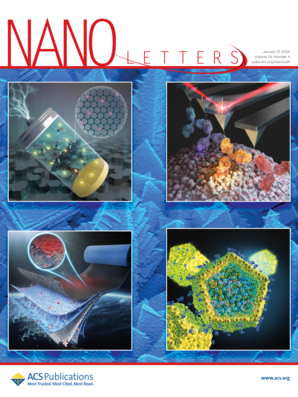Nanoscale Thermomechanical Coupling Study on the Aging of NASICON-Type Solid Electrolytes
IF 9.6
1区 材料科学
Q1 CHEMISTRY, MULTIDISCIPLINARY
引用次数: 0
Abstract
Previous investigations on the aging mechanism of solid electrolytes (SEs) predominantly focused on electrochemical and mechanical properties, often overlooking their thermal characteristics. In this study, we introduced scanning thermal microscopy and scanning thermo-ionic microscopy to delve into the microscopic aging process of the Li1.4Al0.4Ti1.6(PO4)3 (LATP) SE assembled with Li metal. Our findings revealed the formation of a Li3Al0.4Ti1.6(PO4)3 secondary phase during cycling. Compared with the unreacted LATP, this secondary phase exhibits a remarkable decrease in thermal conductivity (from 1.72 to 0.63 W m–1 K–1), Young’s modulus (from 117.4 to 31.3 GPa), and ionic activity, while demonstrating an increase in thermal expansion response. These mismatches worsen the interfacial contact, contributing to the formation of cracks and a sharp increase in impedance. To the best of our knowledge, this is the first time that the thermomechanical coupling of SEs has been studied at the nanoscale, underscoring the pivotal impact of the thermal properties on SE degradation.

nasicon型固体电解质老化的纳米尺度热-机耦合研究
以往对固体电解质老化机理的研究主要集中在电化学和力学性能方面,而忽视了其热特性。本研究采用扫描热显微镜和扫描热离子显微镜研究了Li金属组装Li1.4Al0.4Ti1.6(PO4)3 (LATP) SE的微观时效过程。结果表明,在循环过程中形成了Li3Al0.4Ti1.6(PO4)3次级相。与未反应的LATP相比,该二次相的导热系数(从1.72降至0.63 W m-1 K-1)、杨氏模量(从117.4降至31.3 GPa)和离子活性显著降低,而热膨胀响应则有所增加。这些不匹配使界面接触恶化,导致裂纹的形成和阻抗的急剧增加。据我们所知,这是第一次在纳米尺度上研究SE的热力耦合,强调了热性质对SE降解的关键影响。
本文章由计算机程序翻译,如有差异,请以英文原文为准。
求助全文
约1分钟内获得全文
求助全文
来源期刊

Nano Letters
工程技术-材料科学:综合
CiteScore
16.80
自引率
2.80%
发文量
1182
审稿时长
1.4 months
期刊介绍:
Nano Letters serves as a dynamic platform for promptly disseminating original results in fundamental, applied, and emerging research across all facets of nanoscience and nanotechnology. A pivotal criterion for inclusion within Nano Letters is the convergence of at least two different areas or disciplines, ensuring a rich interdisciplinary scope. The journal is dedicated to fostering exploration in diverse areas, including:
- Experimental and theoretical findings on physical, chemical, and biological phenomena at the nanoscale
- Synthesis, characterization, and processing of organic, inorganic, polymer, and hybrid nanomaterials through physical, chemical, and biological methodologies
- Modeling and simulation of synthetic, assembly, and interaction processes
- Realization of integrated nanostructures and nano-engineered devices exhibiting advanced performance
- Applications of nanoscale materials in living and environmental systems
Nano Letters is committed to advancing and showcasing groundbreaking research that intersects various domains, fostering innovation and collaboration in the ever-evolving field of nanoscience and nanotechnology.
 求助内容:
求助内容: 应助结果提醒方式:
应助结果提醒方式:


